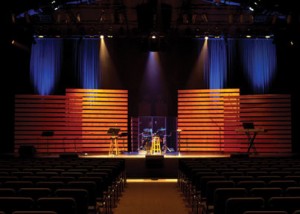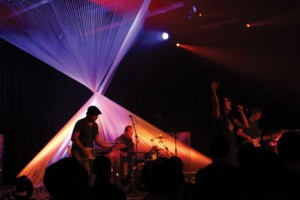
By Jonathan Malm
Many modern churches are making the leap to a more theatrical approach to ministry. Instead of using flowers and ficus to decorate their stages, they are creating environments that more closely match Broadway musicals or U2 concerts.
This trend seems to be growing; in fact, many churches are creating job positions for this type of artist. The position requirements usually involve lighting, scenic design and even graphic design.
Many churches have found that stage design helps their congregations more easily engage with the services. Church workers are seeing stage design as an opportunity to create a visual atmosphere that mirrors what happens with the music and message on the church platform.
 ChurchStageDesignIdeas.com is the leading repository for church staging from congregations all over the world. When you look at the stage designs displayed on the site, you’ll notice two trends in modern church stage design. The first is scenic or literal design. The second is atmospheric or abstract design.
ChurchStageDesignIdeas.com is the leading repository for church staging from congregations all over the world. When you look at the stage designs displayed on the site, you’ll notice two trends in modern church stage design. The first is scenic or literal design. The second is atmospheric or abstract design.
Scenic design
Scenic design is largely influenced by the theater. When you go to a play or musical, you see literal sets. These sets are intended to transport you to a physical location. This might be a forest or a pirate ship.
Many churches are using styrofoam, fabrics and lumber to create these literal scenes. The literal scene is intended to transport the congregation to a location that typically ties in with a sermon series or special event at the church.
Atmospheric design
While many churches are inspired by the theater, others (and a growing number) are inspired by U2 and Coldplay concerts.
These sorts of stage designs are more about the light show and digital projection. Instead of a literal scene, these types of stages use lighting colors and projected images to create an environment that can be changed dynamically to match the mood or emotions on the stage.
Churches are using things like shapes made from corrugated plastic, towers of painted wood, or even string sculptures to create these abstract designs. Then they use lighting or digital projection to “paint” these structures dynamically. Instead of one scene like a forest or pirate ship, the atmospheric stage designer can change the look of the stage multiple times during a church service.
 Atmospheric or abstract stage design is often the less expensive and less involved option for churches. Instead of pouring time and money into elaborate sets, churches are using inexpensive materials to create their abstract structures. Some of the inexpensive materials churches use includes packing tape, bubble wrap, newspaper, aluminum screening material, Styrofoam and lumber.
Atmospheric or abstract stage design is often the less expensive and less involved option for churches. Instead of pouring time and money into elaborate sets, churches are using inexpensive materials to create their abstract structures. Some of the inexpensive materials churches use includes packing tape, bubble wrap, newspaper, aluminum screening material, Styrofoam and lumber.
Churches leading the way
South Hills Church in Corona, CA, has created some very innovative designs using newspaper and bubble wrap. Van Metschke, the church’s technical director, describes stage design in the church like this: “We want to draw our audience’s eyes to the stage to help focus on what we are presenting. Like God, we are creative beings – not only creating, but responding to creativity. It can help show that we care about what we are presenting and who we are presenting to.”
Andrew Hunt from Blue Ridge Community Church in Forest, VA, sees stage design as an opportunity to help their congregation “lower their guard” and engage with the service. Hunt uses materials like foam insulation and corrugated plastic – the material used for real estate signage.
Finally, Denny Weinman at Seacoast Church in Mount Pleasant, SC, uses stage design as a way to accomplish what architects accomplished in old cathedrals – add an aesthetic element to buildings. Denny has used materials like string sculptures, small bits of lumber, and even paper mache in his stage designs.
Because modern church stage design is a somewhat new art, there aren’t many classes or degree plans to help you start. But the leading churches employ construction workers, graphic designers and lighting designers who are willing to experiment with materials to create the stage designs. It’s an exciting new field, and though there may be very few “rules” to this new trend, all churches agree with these two: be creative and be safe.
Jonathan Malm writes and speaks about the creative process. He created and edits ChurchStageDesignIdeas.com and Sunday magazine [www.sundaymag.tv], a free online magazine about the creative side of Sunday mornings at church.
Featured photos: Designed by Denny Weinman for Sugar Creek Baptist Church, Sugar Land, TX. (Photo courtesy of Denny Weinman.)
Designed by Andrew Hunt for Blue Ridge Community Church, Forest, VA. (Photo courtesy of Andrew Hunt.)
Designed by Van Metschke for South Hills Church, Corona, CA. (Photo courtesy of Marvin Sinson.)
__________________________________________
What value does stage design bring to corporate worship?
 Andy Bentley
Andy Bentley
Tech Director/Lighting Designer
Elevation Church,
Charlotte, NC
abentley@elevationchurch.org
One of our responsibilities as church leaders is to create a physical atmosphere of worship that is both excellent and distraction free. When people come to our church, everything they see from the moment they pull in the parking lot is a representation of Christ to them, and they see the stage for 90 percent of their time with us. If we have a stage that is cluttered, messy or designed poorly, it can give people the perception that we don’t care about their experience, and that doesn’t give us a good platform to share Christ with them.
__________________________________________
 Joel Wyant
Joel Wyant
Worship Lighting and Scenic Designer
Southeast Christian Church, Louisville, KY
JWyant@secc.org
As a scenic designer in a church, I strive to create an environment for a corporate worship service that allows people to focus on biblical teaching and engage in authentic worship. While God doesn’t need cool staging or high-tech lighting, it can be used to help lead people into His presence. A good stage design is often the first thing that the congregation sees. It should be something that allows people to put distractions and worries aside and prepare their heart even before the first song or sermon begins.
__________________________________________
 Mark Allen
Mark Allen
Assistant Production Director
First Assembly of God,
Cedar Rapids, IA
mark@lovethischurch.com
I think of stage design and lighting as ways to tie in more senses with auditory during worship. If a stage and lighting design can reel an individual in and help them by forgetting about whatever they would otherwise focus on, I think that’s a win. In the corporate sense, it is a way to attempt to bring a common mood within a congregation.
__________________________________________
 Steve Kent
Steve Kent
Stage Manager
First Assembly of God,
Cedar Rapids, IA
steve@lovethischurch.com
We use stage designs to create a more subdued, warm and comfortable worship atmosphere, which can be a more inviting experience for the church body. Newcomers have often commented that they enjoyed the design and lighting, and that it wasn’t the “church” atmosphere they had expected. It helped them feel comfortable here.
_________________________________________
How to keep the costs of church stage design reasonable?
Stage designs can be as simple or complex as your church budget will allow. Something as simple as a colored par can aimed at a wall can achieve your desired look. Some of our favorite design materials are fabrics that take light well. Coroplast and truss are both extremely versatile. However, most of our designs are nontraditional set pieces.
We have to get creative, and usually start from scratch and make everything ourselves from the ground up. It takes more time and planning, but it is more cost-effective in the end. We also store and reuse a lot of materials, which helps keep cost down.
— Steve Kent and Mark Allen, First Assembly of God, Cedar Rapids, IA
I think creativity is the key element to keep stage design costs reasonable. It’s important to get creative when dreaming up a set by thinking ahead. Like planning on how the set can be reused in the future. Also, it’s handy to find people that enjoy set design and have them help. They will often help you think outside the box. Doing so can save money, not to mention time and effort too.
— Joel Wyant, Southeast, Christian Church, Louisville, KY
Because we have multiple campuses we try to purchase different backdrops for each of them. That allows us to rotate them around to different campuses periodically to keep things fresh. As a lighting designer I also try to rearrange my lighting plot every few months to create different looks on stage without buying more stuff. Another thing we do is use TVs on stage as backdrop elements because we can swap out imagery cheaply and have a customized backdrop based on whatever sermon series we’re in. We try to be good stewards of what God has given us by using everything to its fullest potential. CE
— Andy Bentley, Elevation, Church, Charlotte, NC



Hi guys, thanks for you work. I have a question: My pastor, still like banners with big words in the stage. The thing is that when I am preaching those words behind, I think they distract the people. So, is it good to have those type of banners? They stay there for months.